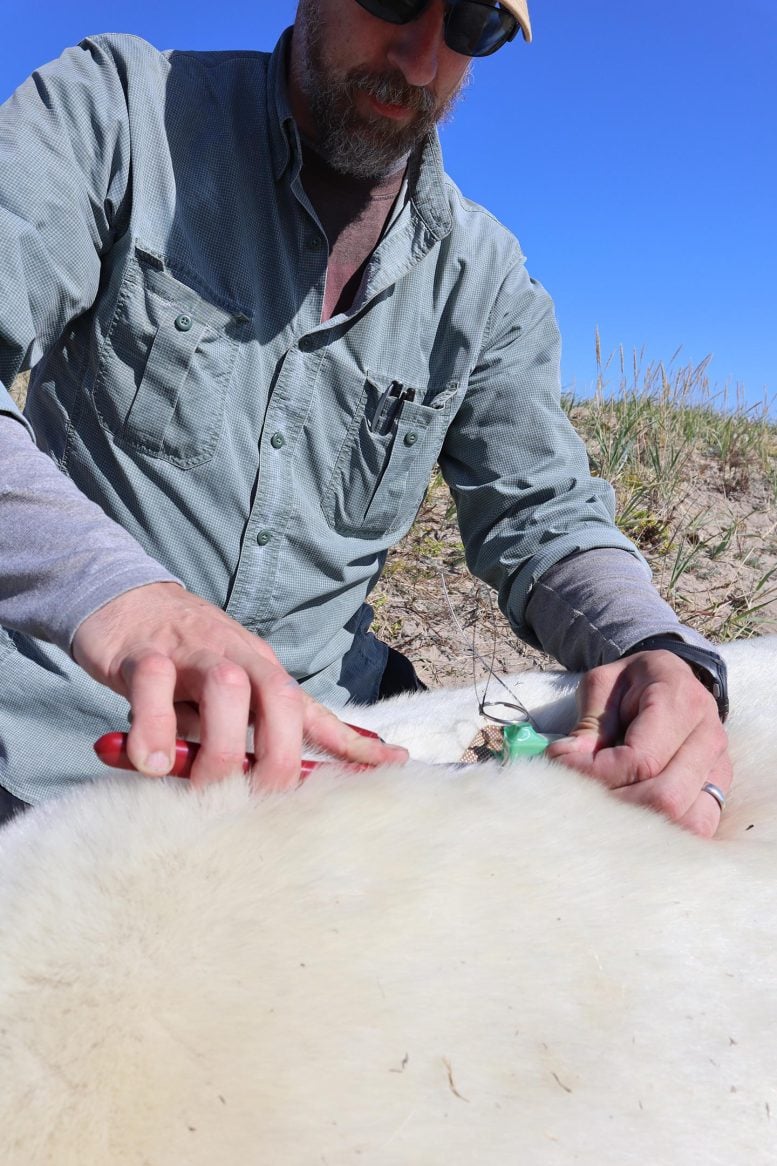
Innovative “Species Corner” trackers now enable effective monitoring of male and adult polar bears, bypassing the limitations of collar-based systems and improving wildlife research and management.
The new “burr in fur” tracking devices provide improved monitoring of adults and subadult male polar bears, a less invasive alternative to traditional collars, and expand research opportunities for previously difficult-to-track demographics.
A research team led by the University of York and a project involving 3M and Polar Bears International has offered the first field study of placing conscious tags on polar bears. The report was published today, Arctic Sea Ice Day.
New tracking technology for polar bears
Studying polar bears just got a lot easier, thanks to new “corner in fur” trackers that confirm scientists’ belief that adults and subadult males spend most of their time lounging on the ground, conserving energy until the ice returns.
A multi-institutional research team led by York University, including the University of Alberta, Environment and Climate Change Canada, Manitoba Sustainable Development, the Ontario Ministry of Natural Resources and Forestry, and Polar Bears International, used three different “burr-on-load” prototypes. study their effectiveness.
Journal, “Collarless Telemetry: Performance of Fur and Ear-Mounted Satellite Tags to Assess Movement and Behavior in Polar Bears,” published in the magazine Biotelemetry of animalsdetails the first peer-reviewed examination of these new tracking devices attached to polar bear fur.

New tracking technology offers breakthroughs in researching male and subadult polar bears, increasing conservation efforts and data accuracy. Credit: Kt-Miller, Polar Bear International
Advances in polar bear tracking techniques
Studying polar bears is a difficult feat, with current radio collars only suitable for female bears that leave a fraction of the population, but new technology is providing researchers with a new tool to document the behavior of large male polar bears on land. waiting for the ice to reappear.
Efforts to develop minimally invasive tracking options and tools that can work on polar bears of both sexes and nearly all ages have met with mixed success over the years. Collars have been and continue to be the primary means of studying polar bear movement. Recently, ear tag transmitters have been used as a lighter alternative. Although both technologies play an important role in polar bear research and conservation, researchers are constantly striving to develop methods that are minimally invasive and provide high-quality data.
This has led to a new tracking initiative called Burr on Fur, launched by Polar Bears International as a challenge to scientists at 3M, the global science and manufacturing company behind Post-It notes, to create a temporary, simple method for small adhesives. polar bear fur tracking units. Three Burr on Fur prototypes were recently tested on wild polar bears along Canada’s Hudson Bay coast, along with traditional earpiece transmitters.

Professor Greg Thiemann of York University celebrates the polar bear. Credit: University of York researcher Tyler Ross, Polar Bear International
Comparison of new and traditional tracking devices
Ear tags and Burr on Fur devices are important to scientists and wildlife managers. The new tags allow researchers to track the movements of adult male and great polar bears, two groups that cannot be studied using traditional satellite collars. Adult males cannot wear collars because their conical necks and heads slide off, and large bears grow too quickly to safely use a collar. Traditional ear tags are an alternative to collars. However, they sometimes require recapture to remove and, although rare, may pose a risk of ear damage. The new Burr on Fur tags are designed to be temporary, minimally invasive and can be used on both sexes and polar bears of almost any age.
“Successfully attaching telemetry tags to polar bear fur has never been done before, and we are excited to share the results of this innovative work,” said Tyler Ross, lead author of the paper and researcher at York University. great promise and will allow researchers to study the behavior and movements of polar bears about which we have very little information, such as adult male bears.

Three fur tag design. Credit: University of York researcher Tyler Ross, Polar Bear International
Field testing of innovative control technologies
Fifty-eight wild bears were tagged with ear tags and three different fur tag designs to compare the amount of time they remained active when attached to bears and bears. accuracy of trackers. Three hair tags used next to the traditional ear tag based on the Argos transmitter:
- Pentagon tag: this five-sided instrument contains five holes punched in the corners, which allow the hairs to be pulled out. He used an Argos Eartag satellite transmitter.
- SeaTrkr tag: an oval-shaped tag with 10 holes to allow 10 hair-tuft attachments. This design used Telonics associated with Iridium GPS SeaTrkr-4370 transmitter.
- The Tribrush Tag: a triangular tag fitted with tubes along the edges, through which the tube brushes trap the wool and turn it into the tubes. This tag used the same Argos transmitter as the Pentagon tags.
The study was conducted from the fall of 2016 to 2021 near Churchill, Canada, by the polar bear warning program and researchers from the University of Alberta, supplemented by the operations of researchers from Environment and Climate Change Canada, the Ontario Ministry of Natural Resources and Forestry. , York University and Manitoba Sustainable Development near the Manitoba-Ontario border in 2021-22.
Results and performance analysis of new tags
“Our findings are an important step towards better understanding the movement and behavior of polar bears, especially adult males, as they cannot be fitted with satellite collars. “Temporary fur tags can help track the movements of displaced bears after human conflicts, making these tags an important tool for polar bear conservation and keeping northern communities safe.” Grigory Thiman, co-author of the report.
The top performer was the SeaTrkr tag, which stuck to bears for an average of 58 days and had the highest accuracy thanks to the use of GPS/Iridium technology. In second place, Trishbrush Tags remained attached for an average of 47 days. However, the times for the Tribrush Tag varied, with one falling after only two days and another lasting 114 days – the longest of all tags.
Because they are permanently attached to a bear’s ear, traditional ear tags last an average of 137 days, while short-term leather trackers have proven to be reliable for short periods. Fur tags have proven useful for monitoring bear behavior and show great promise for future use in tracking polar bears, particularly polar bears that need to be relocated after coming too close to communities. Further testing and refinement is being done on bears in zoos and aquariums through the Polar Bears International Arctic Ambassador Center zoo and aquarium partners, allowing researchers to further refine the designs and see how they perform in different seasons. In the last round of testing at the zoo, the cleared tag remained on the bear for 75 days.
Important facts about the male and the great polar bear
The new data add to our growing understanding of the movements and behavior of adult and subadult male polar bears, which have historically been understudied because they cannot be safely trapped for long periods of time. The research confirms that adult and subadult male bears decrease their activity when they walk on land, consistent with previous research that showed bears spent about 70 to 90 percent of their time resting during the ice-free period in Hudson Bay.
Implications for wildlife management
While ear tags stick to bears for a long time, temporary and easily attached fur tags give scientists a new tool to better track bears for applied research and management of human-bear interactions. The tracking technology can be applied to other bear species to support efforts to reduce human-bear conflict, and future applications may include trials on other bears. types with wool. Traditional tracking methods such as collars will remain important for long-term research, but furballs will become a valuable tool for understanding and managing human-wildlife interactions, especially with climate change.
“The collaboration between Polar Bears International, 3M, academic institutions, and government partners is a testament to our commitment to advancing Arctic wildlife research and conservation technology,” said Jeff York, Polar Bears International’s senior director of research and policy. will have a significant impact, help monitor polar bears and help improve human-bear coexistence. We are committed to further development and deployment of this key technology.”
About the Arctic Sea Ice Day
The findings were announced on July 15, Arctic Sea Ice Day, an annual event organized by Polar Bears International to promote action and conversation about the rapidly melting Arctic ecosystem, including its global importance and how humans can help slow this warming trend. to organize. The Arctic is now warming almost four times faster than the rest of the planet, which is causing sea ice to melt, which is causing polar bears to fast longer on land.
Polar Bears International invites the public to read the full report and invites the scientific community to consider the implications of these findings for further research and use in conservation and coexistence efforts.
Reference: “Collarless Telemetry: Performance of Fur and Ear-Mounted Satellite Tags to Assess Movement and Behavior in Polar Bears” Tyler R. Ross, Gregory W. Thiemann, B. J. Kirschhoffer, John Kirschhoffer, Jeff York, Andrew E. Derocher, Amy K. Johnson, Nicholas J. Lunn, David McGeachy, Vicky Trim, and Joseph M. Northrup 15 Jul 2024 Biotelemetry of animals.
DOI: 10.1186/s40317-024-00373-2
#Watch #scientists #track #polar #bears #Angle #Species #tags